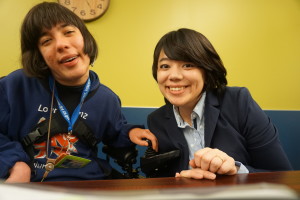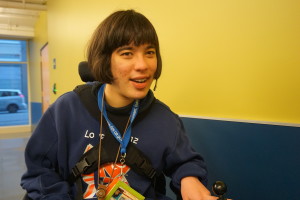This article is also available in: 日本語
Hi, it’s Mizuki!

Independent living is one of the challenges that many people with disabilities face before they start to work.
In San Francisco, I visited Independent Living Resource Center San Francisco and talked with Ms. Fiona Hinze, a Systems Change Coordinator and Community Organizer.

Fiona has Cerebral Palsy and uses a wheelchair in her daily life.
She grew up in San Francisco and went to a school that provides full inclusion education, which means she received general education with non-disabled students.
She even went to Stanford University and studied psychology.
After she worked as an intern at Independent Living Resource Center San Francisco, she got offered her current full-time position.
Her main job is policy work for people with disabilities.
In 1972, Center for Independent Living was founded by disability activists in Berkeley, California.
After that, Independent Living Centers have expanded across the country.
Independent Living Resource Center San Francisco is one of these centers.
Independent Living Resource Center San Francisco is based on the peer-run model.
That means that the majority of employees themselves have disabilities so that they can provide better service, including information and advice, for people with disabilities to assist them in living independently.
Fiona said, “Persons with disabilities are experts on their own disabilities”.
I totally agree!
Independent Living Resource Center San Francisco is a cross–disability organization.
Everyone who self-identifies himself or herself as having a disability can use the services.
They provide housing advocacy, assistive technology, benefits counseling and information, medicare counseling, and more.
They don’t give direct employment service for people with disabilities, but they do host a monthly Economic Empowerment workshop where employers come and talk to people with disabilities about job possibilities.

Fiona pointed out 3 issues that people with disabilities have faced in the US:
Employment, Architectural access, and stigma.
1. Employment
High unemployment rates for people with disabilities are a huge issue.
According to The U.S. Department of Labor, the unemployment rate of people with disabilities is 10.3%, which is more than twice the rate for people without disabilities, which is 4.6%.
Currently, according to scholars of disability studies, there isn’t a method which can accurately estimate the number of employment rate of people with disabilities, yet, and the actual unemployment rate of people with disability may be as much as twice higher.
2. Architectural Access Barriers
After the ADA passed in 1990, most of the buildings became accessible, and that changed the lives of people with disabilities.
However, there are still many improvements that need to be made in terms of access to buildings.
One of these issues is housing.
There are few accessible houses or apartments, which prevents independent living for many people with disabilities.
3. Stigma
Some people still have negative images of people with disabilities.
At the same time, some people with disabilities themselves feel that they cannot do things because of their disabilities.
These stigmas narrow their capabilities and reduce possible opportunities.
To be continued…
